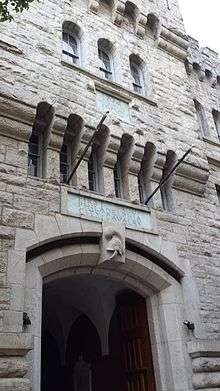First Troop Philadelphia City Cavalry
The First Troop Philadelphia City Cavalry, also known as the First City Troop, is a unit of the Pennsylvania Army National Guard. It is the oldest military unit in the United States still in active service.

History
The First Troop Philadelphia City Cavalry, or "First City Troop", was organized in 1774 as the Light Horse of the City of Philadelphia, often referred to as the Philadelphia Light Horse, one of the first patriotic military organizations established in the American Revolution. It is the only military unit in the US that owns its own armory building, built with private funds in the Rittenhouse section of Philadelphia.
Abraham Markoe was the founder and the first Captain[1] of the Philadelphia Light Horse, known today as the First Troop Philadelphia City Cavalry.[2]
Early members came from a number of local social organizations, including the Schuylkill Fishing Company, the Schuylkill Company of Fort St. Davids, the St. Andrew's Society of Philadelphia, the Society of the Friendly Sons of St. Patrick, the Society of the Sons of St. George, and especially the Gloucester Fox Hunting Club. Captain Samuel Morris was Gloucester's first president and Captain Robert Wharton its last.
During the Revolution, the troop fought in the battles of Trenton, Princeton, Brandywine, and Germantown. It often served as George Washington's personal bodyguard. The unit also saved James Wilson at the "Battle of Fort Wilson" riot.
During the American Civil War, the First City Troop was called into active duty several times, beginning with the 1861 Campaign that led to the First Battle of Bull Run. During the Gettysburg Campaign, the company, under the command of future U.S. Speaker of the House Samuel J. Randall, performed scouting duties around Gettysburg, Pennsylvania, in late June before fleeing to neighboring York County following a brief skirmish on June 26, 1863. The company later helped defend the Columbia-Wrightsville Bridge against the Confederate forces of John Brown Gordon.
John J. Pershing said that "no National Guard organization in the country did more, relatively, in the First World War than the [First Troop Philadelphia City Cavalry]."[3]
Today, the First City Troop deploys overseas with the Pennsylvania National Guard in support of Army operations. Recent deployments have been to Bosnia, Iraq, and Egypt. Membership is by election. Soldiers on the active roll continue to donate their drill pay back to the unit, in order to maintain a tradition of voluntary service.
The troop draws its membership from Troop A, 1st Squadron, 104th Cavalry Regiment, 28th Infantry Division (United States), Pennsylvania Army National Guard.
As of October 2014, the troop had 35 active members, down from 86 in 2000.[4]
References
- ↑ "History:Philadelphia (1774–1775)". FTPCC web site. First Troop, Philadelphia City Cavalry. Archived from the original on 18 August 2010. Retrieved 2010-09-01.
Abraham Markoe, a Danish subject, was chosen to be the first Captain because of his energy in organizing the Troop and his previous Danish military experience. Though prevented from open participation in the War as a result of the Neutrality Edict issued by then King Christian VII of Denmark, Captain Markoe took an active part in the defeat of the enemy by all other available means.
- ↑ Johnson, Robert (2006). Saint Croix 1770–1776: The First Salute to the Stars and Stripes. AuthorHouse. p. 20. ISBN 978-1-4259-7008-6.
This same Abraham Markoe, in 1775, organized the Light Horse Troop of Philadelphia, and presented the troop with what is considered the first flag with thirteen stripes representing the thirteen colonies.
- ↑ Hudson, Richard L. 1980. "At Ease, Troopers: Fall Out for Caviar and Pickled Herring. That's the Order Often Heard at Elite Philadelphia Club, A Unit of the National Guard." Wall Street Journal. February 29, 1980. Page A1
- ↑ Phillips, Michael (October 15, 2014). "Philadelphia Is Looking for a Few Good Gentlemen". New York. Wall Street Journal. Retrieved October 21, 2014.
Further reading
- Brooke, George, III. With the First City Troop on the Mexican Border. Philadelphia: 1917.
- Clark, William P. Official History of the Militia And the National Guard of the State of Pennsylvania from the Earliest Period of Record to the Present Time. 3 vols. Philadelphia: 1909-1912.
- First Troop Philadelphia City Cavalry. By-Laws, Muster Roll, and Papers Selected from the Archives of the First Troop Philadelphia City Cavalry, 1840.
- First Troop Philadelphia City Cavalry. History of the First Troop Philadelphia City Cavalry; From Its Organization November 17th 1774 to Its Centennial Anniversary .... Philadelphia: Hallowell, 1875.
- Hendler, Charles J., compiler. Official History of the Militia and National Guard of the State of Pennsylvania. 4 vols. Philadelphia: 1936.
- Hudson, Richard L. 1980. "At Ease, Troopers: Fall Out for Caviar and Pickled Herring- That's the Order Often Heard at Elite Philadelphia Club, A Unit of the National Guard." Wall Street Journal. February 29, 1980. Page A1, A26.
- McBarron, H. Charles, Jr. (March 1951). "First Troop Philadelphia Light Horse, 1809-1815". Military Collector and Historian. 3: 14–16.
- Risley, Clyde A.; James P. Simpson; and John R. Elting. "Light-Horse of the City of Philadelphia, 1776-1777." Military Collector and Historian, 23 (Winter 1971), pp. 121–122.
- "A Return of the First City Troop, 1799." Pennsylvania Magazine of History and Biography, 23 (1899), p. 127.
- Scharf, John Thomas; Thompson Westcott (1884). History of Philadelphia, 1609-1884. Phila.: Lippincott.
- Meschter, G. Andrew. "The Gentlemen of Gloucester: A New Look at the First Troop Philadelphia City Cavalry" Agamemnon Publishing, 2015.
External links
- Official history
- First City Troop in the Spanish–American War
- Initial roster
- Gentlemen of Gloucester
Coordinates: 39°57′12″N 75°10′42″W / 39.953246°N 75.178415°W